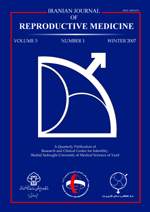
|
International Journal of Reproductive BioMedicine
Research and Clinical Center for Infertility, Shahid Sadoughi University of Medical Sciences of Yazd
ISSN: 1680-6433
EISSN: 1680-6433
Vol. 17, No. 12, 2019, pp. 891-906
|
 Bioline Code: rm19091
Bioline Code: rm19091
Full paper language: English
Document type: Research Article
Document available free of charge
|
|
|
International Journal of Reproductive BioMedicine, Vol. 17, No. 12, 2019, pp. 891-906
| en |
Derivation of new human embryonic stem cell lines (Yazd1-3) and their vitrification using Cryotech and Cryowin tools: A lab resources report
Akyash, Fatemeh; Tahajjodi, Somayyeh Sadat; Yazd, Ehsan Farashahi; Hajizadeh-Tafti, Fatemeh; Sadeghian-Nodoushan, Fatemeh; Golzadeh, Jalal; Meimandi, Hassan Heidarian; Moore, Harry & Aflatoonian, Behrouz
Abstract
Background: Cell banking of initial outgrowths from newly derived human embryonic stem
cells (hESCs) requires an efficient freezing method. Vitrification is used for the preservation of
gametes and early embryos in assisted reproduction techniques (ART). Moreover, vitrification
was applied for cryopreservation of hESCs using open pulled straws.
Objective: To derive and characterize new hESC lines and then use Cryotech and Cryowin tools
for their vitrification.
Materials and Methods: Human ESC lines were generated in a microdrop culture system using
mouse embryonic fibroblasts (MEFs) as the feeder layer; this was later scaled up using both
MEFs and Yazd human foreskin fibroblasts batch 8 (YhFF#8). To bank the cell lines, master cell
banks of 100 Cryotech and Cryowin tools were produced for each individual cell line using the
vitrification method; flasks of hESC lines were also cryopreserved using a conventional slow-freezing
method.
Results: The pluripotency of cell lines was assessed by their expression of pluripotencyassociated
genes (OCT4/POU5F1, NANOG, and SOX2) and markers such as SSEA4, TRA-1-60, and TRA-2-49. Their in vitro capacity to differentiate into germ layers and germ cells
using embryoid body (EB) formation and monolayer culture was assessed by screening the
expression of differentiation-associated genes. The chromosomal constitution of each hESC
line was assessed by G-banding karyotyping.
Conclusion: Cryotech and Cryowin tools used to vitrify new hESCs at an early stage of derivation
is an efficient method of preserving hESCs.
Keywords
Derivation; Human embryonic stem cells; Human foreskin fibroblast; Microdrop; Vitrification.
|
| |
© Copyright 2019 - Akyash et al.
Alternative site location: http://www.ijrm.ir
|
|
